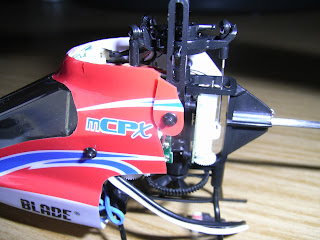At last on Monday of this week I did manage to get the chance to pack my bag with the mCPx and Spektrum DX7 and head off down to the flying field and put a couple of packs of lipos through...yes, that reminds me - when it comes to lipos for the mCPx do invest in as many packs of the Turnigy nano-tech 300mAh 35C batteries as you can. They fit the Blade mCPx without modification, the extra capacity of the 300mAh gives you longer flight time and being 35C you get the extra zip you really need to get this little heli moving. It really is needed for 3D flying and really for any type of flying where you have wind to contend with. (If these figures leave you bemused then take a look at the RC Helicopter Fun website - it's loaded with information and he gives you easy to understand and in depth rundowns depending on the level you want. For the ABC on lipo batteries click HERE ).
It was not a still day by any means but we actually had some bright sunshine - not always helpful this time of the year as it is so low in the sky, so you have to keep it in mind when flying. One of the nice things about the mCPx for someone starting out with a collective pitch helicopter is the smooth transition when on standard setting between the 3 flight modes (if using a DX7). Of course its stability and resilience to crash impacts are huge reasons to favour it, plus the fact that it is generally just a great helicopter that no matter what you level of competence (once you have at least a small amount) you can always get something out of this little heli...and largely that something is loads of fun. Plus it is a heli that just grows with you as you grow with it.
Now this day was one when i was going to test the resilience of the mCPx - not by design. Flying it round first getting the feel of it again after not having been out with it I thought I would have a go at some new inverted manoeuvres I have been practicing on the flight simulator - the result a couple of heavy power on impacts into the ground, fortunately nice soft grass after all the rain we have had. It is actually quite a smart move finding some grass to fly over when your starting or trying out something new. The result of the impacts, well it through the main gear as usual...just a push back on job and off we go again. The second impact did result in breaking the canopy and a piece came clean off, while part was retained by the canopy supports. Here are the pictures:
 |
| Right side: as it should be. |
 |
| Left side: with the crash modification |
You can see what a tidy job I made of the modification. I certainly shall not need to rush out to buy a order a new canopy...and it flies fine still, so no other damage done.
Back to the flight sim for more practice I think!!!
To finish this post off I thought I would just add a note on the importance of a correctly set up swash plate in order to get a collective pitch helicopter to be a pleasure to fly rather than a handful. Below are pictures taken of the 450 size helicopter I am finishing off show how a swash plate should look:
 |
| Low Stick Position - Swash at Lowest Point |
 |
| Mid Stick - Swash at Middle of Range |
 |
| High Stick position - Swash at Highest Point |
To finish off with...a teaser video...




